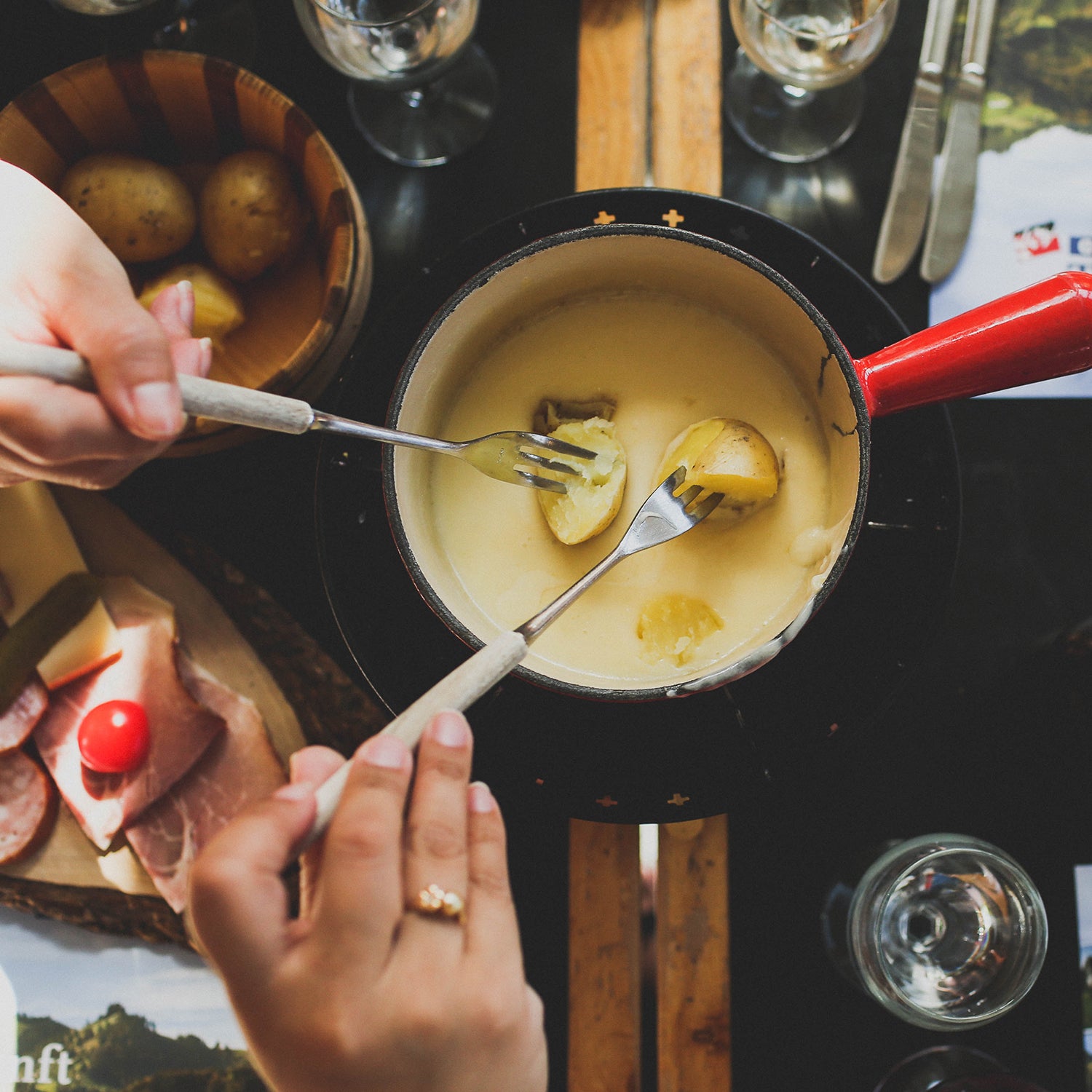Ski season means one thing: itŌĆÖs time for fondue. This ultimate apr├©s dish is well-suited for the meanest winter weather, but what are the best ways to enjoy the steaming-hot, cheesy delight on a cold winterŌĆÖs day? For all your fondue-based questions, we have answers. Read on for a primer.
The Backstory
The alpine tradition of fondue isŌĆ” complicated. A debate rages as to where fondue technically originated. The Swiss lay claim, as do the FrenchŌĆöspecifically, the French from the mountainous region of Savoy. Some also argue that ItalyŌĆÖs Aosta region is its native home. Fondue appears to have been invented in the western Alps, an expansive area that encompasses all three countries, says Jessica╠²Sennett, a 15-year veteran of the cheese industry and the founder of , a line of cheese-storage boxes and accessories. ŌĆ£The origin of the word fondue comes from the French and Italian verbs fondre and fondereŌĆöŌĆśto melt,ŌĆÖŌĆØ she says. ŌĆ£Fondue was originally conceived as a way to stretch limited rations of food during the winter months.ŌĆØ
Cheese, stale bread, wine: dinner is served. Italians created a melted concoction of egg, butter, and milk, but the tradition of melting cheese typically held. These days, the intention of fondue as a stylish, cool, and tasty winter meal designed to accompany a day of skiing may feel at odds with the ethos of making do, but it all comes from the same placeŌĆöa place of comfort. Apr├©s-ski is the laid-back moment of enjoyment that we seek after weŌĆÖve done the hard work. ThatŌĆÖs not really so different from the comfort sought during dinner at a home way up in the mountains in times of hardship. In both cases, it brings a bit of joy.
Where to Begin
When shopping for a fondue pot, youŌĆÖll need to consider your heat source (Sterno canned heat, an electric source, or even a candle), the material of the pot (cast iron, copper, stainless steel, ceramic), and the type of heat control. Some pots come with luxe extras, like color-coded forks, heat guards, and slotted rims. Price points can be all over the placeŌĆöand so can capacities. But versatility is high on this list, and for that, the brushed stainless-steel ($80) fits the bill. Unlike some other pots, it╠²offers an adjustable thermostat, so you can easily control the temperature settings. ŌĆ£If youŌĆÖre looking for a fondue pot that is well-suited╠²to melting not only cheese but chocolate as well, this is an incredibly durable pot,ŌĆØ says Sennett.╠²ŌĆ£I also always love stainless steel for heat distribution with cheese dishes.ŌĆØ
For those seeking a more traditional option, Sennett suggests the ($120). ŌĆ£This enameled cast-iron pot in cherry red is excellent at retaining heat and gives a nod to the Swiss,ŌĆØ she says. She also recommends the ($100). With a lid that retains heat, this sturdy, cast-iron fondue pot has a ŌĆ£heavier luxury feel to it,ŌĆØ than the other Swissmar, Sennett says. Both pots are more analog than digital, so youŌĆÖll have to monitor the temperature yourself. While a fondue pot is the best way to get and control the perfect cheese consistency, you can also use a heavy-bottomed pot for your feast. Just make sure itŌĆÖs set on a form of constant low heat, like a hot plate.
The Big Cheese
So, youŌĆÖve got your pot. Now what? The most classic fondue cheese is Gruy├©re AOP, ŌĆ£due to its meltability and full flavor,ŌĆØ says Sennett. ŌĆ£The meaty, oniony, savory profile of the cheese really comes to life when melted,ŌĆØ she says. But not all Gruy├©re is created equal, and you can customize your fondue by selecting competing ages of cheeses. ŌĆ£A younger Gruy├©reŌĆösix monthsŌĆöhas higher meltability than the more aged wheel,ŌĆØ Sennett says, while ŌĆ£a 12-month, 1655 Gruy├©re will bring a depth of flavor to the fondue pot.ŌĆØ If you use a more aged cheese, Sennett advises blending the cheese with another Swiss classic, Vacherin Fribourgeois AOP. Other accessible cheeses with good melting points include Emmentaler, Fontina, raclette, and young Gouda. ŌĆ£These can also be blended with denser cheeses, like a 17-month-old clothbound cheddar,ŌĆØ she says.
From May to October, cheese enthusiasts can find LŌĆÖEtivaz AOP, a handmade, herbacous cheese crafted from raw milk over an open fire. (Like produce, some cheeses are seasonal, reflecting the milking cycle.)
Although you can buy cheese for fondue at the grocery store, youŌĆÖd be better served to seek out a monger and talk through the best options with a knowledgeable source. If youŌĆÖre having trouble finding some of the recommended cheeses, ask a cheesemonger or someone working behind the cheese counter at your grocery store for the best substitutes. And donŌĆÖt be afraid to experiment.
The Big Dip
Sure, the cheese is important, but it wouldnŌĆÖt be a fondue party without the extras. In some sense, what you serve with fondue is a matter of personal preference. Sennett suggests day-old bread, boiled or roasted potatoes, blanched vegetables, pickles, pears, apples, and grapes. ŌĆ£Day-old bread is better than fresh bread for dunking into melted cheese, as the cheese sticks to it well,ŌĆØ she says. ŌĆ£The day-old bread will also soften in the warm, melted cheese, making it the perfect texture and vehicle.ŌĆØ
DonŌĆÖt be afraid to take risks. That jar of oil-cured olives buried in the back of your refrigerator? Absolutely. Medjool dates? Why not! Fondue lends itself to a wealth of flavors, from savory to salty to sweet. Experiment with foods that already live in your pantry. Consider fondue an opportunity to display some of your more interesting food finds.
You can pair fondue with wine, like a dry Riesling or a sparkling brut. (Sennett also suggests medium-red wines with low tannins). ŌĆ£Fondue itself needs alcohol in the recipe to break down the melted cheese into a smooth texture and to add a depth of flavor,ŌĆØ she notes. ŌĆ£This alcohol can be a kirsch, Calvados, grappa, or Pfl├╝mliŌĆöwhich are great accompaniments while eating the fondue as well.ŌĆØ Fortified wines, like Madeira, sherry, or even port, are also stellar pairings with fondue, should you prefer a drink with a trace of residual sugar.
The Recipe
American Artisan Cheese Fondue, from Jessica Sennett
A spin on the classic alpine cheese fondue to highlight the rich, American artisan cheeses with alpine flavor
Ingredients
- 1 medium clove garlic, cut in half
- 1 cup dry Riesling (SennettŌĆÖs favorite dry white wine for pairing with cheese)
- 1/4 pound Deer Creek Cheese the Stag Clothbound cheddar, grated (or substitute a similar sharp, aged cheddar)
- 1/4 pound Jasper Hill Farm Alpha Tolman cheese (or substitute a similar style Gruy├©re)
- 1/2 pound Reading raclette, grated (or substitute Appenzeller or Emmental)
- 1 tablespoon cornstarch
- 1 tablespoon fresh lemon juice
- 1 tablespoon Calvados (optional)╠²
- Kosher salt and freshly ground white or black pepper
- Toasted bread, cubed, and/or lightly blanched vegetables for dipping
Instructions
Rub the cut faces of garlic around the inside of a fondue pot. Add wine and heat on low until steaming. In a large bowl, evenly coat the three cheeses with cornstarch.
Maintaining low heat, add the cheese one handful at a time, stirring until almost fully melted before adding the next handful. Continue until all of the cheese is melted into the wine. You want the melted cheese to be smooth and glossy, which can take up to ten╠²minutes of stirring. Keep your pot at a low temperature, and never bring the melted cheese to a simmer, as the cheese could break. Stir in lemon juice and Calvados, if using, until fully incorporated. Season with salt and pepper.
Keep the fondue pot warm at the table. Serve with the toasted bread cubes and crisp, blanched vegetables for dippingŌĆöor any other finger food of choice╠²that you or your guests prefer. If the fondue begins to thicken too much over time, add a small splash of wine to thin it.


